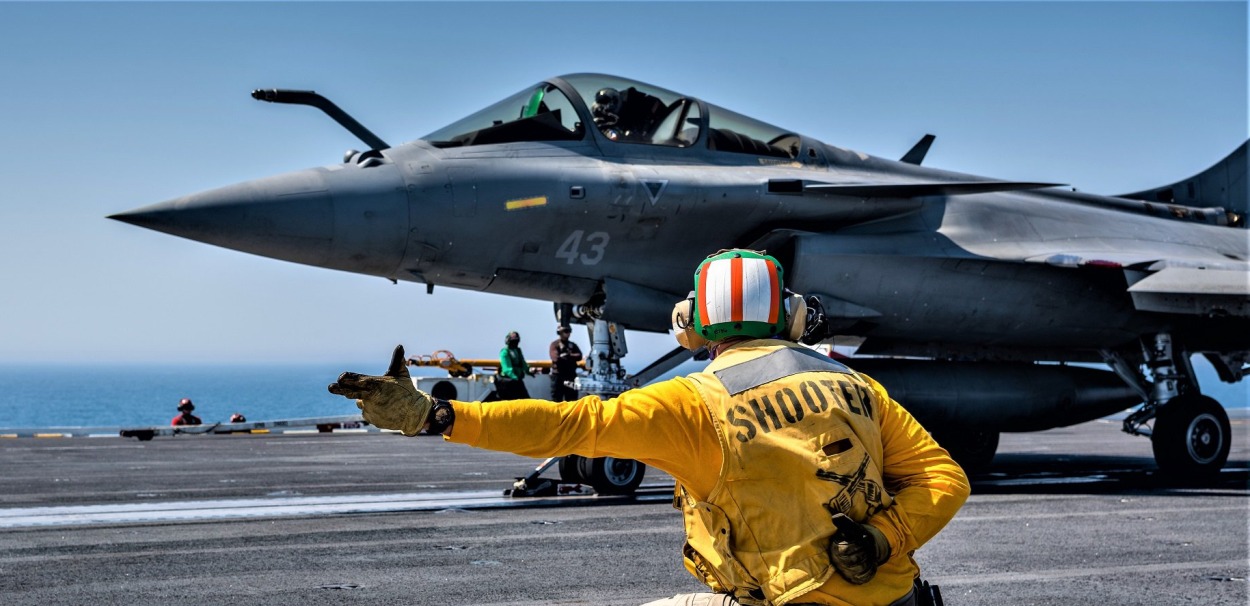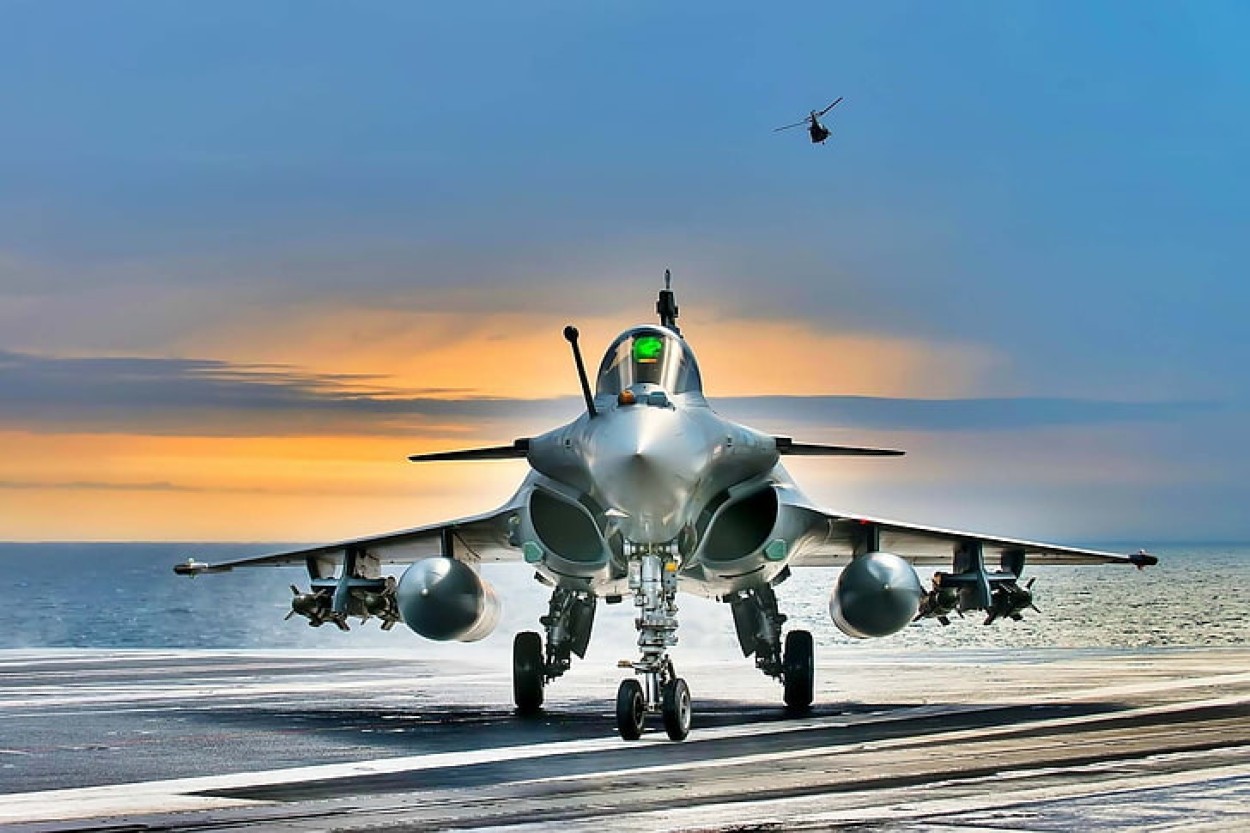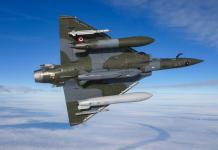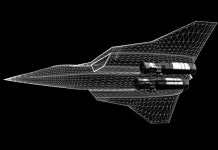In what is arguably one of the most significant defense acquisitions in India’s maritime history, New Delhi has cleared a government-to-government deal worth over Rs 63,000 crore (approx $7.5B) to procure 26 Rafale Marine fighter aircraft from France.
This strategic move—much more than just a hardware transaction—is poised to elevate India into the rarefied club of nations that can project formidable Carrier Battle Group (CBG) capabilities across vast oceanic expanses.
The deal includes 22 single-seater Rafale M fighters and four twin-seater variants, all configured for carrier operations. These fighters will be deployed aboard India’s two aircraft carriers, INS Vikramaditya and the indigenously-built INS Vikrant. The implications are deep—not just for the Indian Navy’s aerial teeth but also for India’s geostrategic stance in the Indo-Pacific theatre.
The Rafale Marine: Battle-Hardened & Future-Ready
The Rafale M is not just another multi-role fighter. It is a battle-hardened machine with credentials forged in real combat.
Operated by the French Navy aboard the Charles de Gaulle aircraft carrier, it has seen action in Afghanistan, Libya, Iraq, and Syria—delivering precision strikes, providing air superiority, and performing deep interdiction roles.
It is equipped to operate from STOBAR carriers like the INS Vikramaditya and Vikrant with minimal modifications and has a weapons package that makes it arguably one of the most potent carrier-based aircraft in the world.
Its arsenal includes the unmatched beyond-visual-range (BVR) Meteor missile, which has an unmatched no-escape zone, the MICA missile for close-combat supremacy, and the precision HAMMER bombs, which offer surgical strike capabilities with standoff range.
These weapons can be fused with nuclear capabilities, giving India a credible air-delivered nuclear option from the sea—a dimension that no regional adversary can ignore.

Why Tejas Didn’t Make The Cut
India’s own LCA Navy program has made commendable progress, but during the trials aboard the aircraft carriers, it became clear that it lacked the maturity and operational reliability for full-fledged carrier operations. Issues related to weight, thrust-to-weight ratio, and maintenance footprint made it unfit—at least in the current avatar—for the rigors of maritime operations from a carrier deck.
This is not a setback but a realistic admission that carrier-borne operations demand a level of ruggedness and mission readiness that takes decades to master.
With Rafale M’s proven deck handling, folding wings, reinforced landing gear, and tailhook operations, the Indian Navy is buying time and capability while HAL and ADA continue to work on the Twin-Engine Deck-Based Fighter (TEDBF) for the future.
Carrier Battle Groups: Power Projection Tools, Not Mere Fleets
Carrier Battle Groups are not just naval vanity projects. They are floating sovereign airbases capable of enforcing will far from home shores. The combination of aircraft carriers, destroyers, frigates, submarines, replenishment ships, and airborne assets form a protective and offensive envelope unlike any other.
With Rafale M on board, India’s CBGs now get:
Expanded Capabilities of Rafale M in India’s Carrier Battle Group
-
Air Dominance:
Armed with the Meteor Beyond Visual Range Air-to-Air Missile (BVRAAM)—arguably the most lethal air dominance missile in the world—the Rafale M ensures no hostile aircraft or UAVs come within threatening range of the carrier fleet. With the MICA missile family (IR and RF variants), it also dominates within-visual-range (WVR) dogfights and provides 360-degree engagement capability. Together, they give India a decisive aerial superiority bubble around its naval task forces.
-
Strike Capability:
The HAMMER (Highly Agile Modular Munition Extended Range) precision-guided bombs allow the Rafale M to strike key installations on enemy-held islands, ships at sea, or coastal radars—even in GPS-denied environments. With future integration of SCALP EG cruise missiles, the Rafale M will gain a deep-strike reach beyond 500 km, allowing preemptive or punitive strikes without overflying hostile airspace.
-
Nuclear Second-Strike:
The Rafale platform can be integrated with India’s air-delivered nuclear bombs or gravity-based nuclear weapons, extending the survivability and credibility of India’s second-strike capability. When operating from a carrier, these aircraft enhance India’s maritime nuclear deterrence, offering mobility and flexibility to its strategic forces.
-
Electronic Warfare Superiority:
The SPECTRA EW suite offers all-spectrum detection (radar, laser, and infrared), threat identification, jamming, decoy deployment, and automatic threat avoidance. This allows Rafales to operate inside heavily contested and sensor-rich environments like the South China Sea or Persian Gulf—where radar silence or stealth is key to survival.
-
Network-Centric Warfare Integration:
The Rafale M is equipped with Link 16-equivalent encrypted datalinks, allowing it to share real-time tactical data with warships, AEW&C platforms like the Indian Navy’s Ka-31 or IAF’s Netra, and ground-based assets. This ensures seamless command and control in a dynamic combat environment.
-
Multirole Flexibility:
Unlike legacy aircraft with limited mission adaptability, Rafale M can switch between air superiority, deep strike, maritime strike, and reconnaissance missions mid-sortie. This multi-role adaptability reduces the logistical footprint and simplifies air wing planning aboard carriers.
-
Carrier Compatibility and Deck Suitability:
Designed specifically for carrier operations, Rafale M features reinforced landing gear, tailhooks, foldable wings, and compatibility with ski-jump takeoffs—making it ideal for India’s STOBAR carriers (INS Vikrant and Vikramaditya). It reduces the need for extensive modifications and pilot retraining.
-
All-Weather, All-Environment Operations:
With its powerful radar (RBE2 AESA), terrain-following modes, and synthetic aperture capabilities, the Rafale M can operate in rain, fog, night, or sandstorm conditions. It is built for global deployment under diverse environmental stresses.
-
Low Observability and Survivability:
Although not stealthy like 5th-gen fighters, Rafale M uses radar-absorbent materials, low infrared signature engines, and advanced jamming systems to enhance survivability and reduce its detectability on enemy radar systems.
-
Maritime ISR & Battle Management:
With advanced electro-optical sensors, ground-moving target indicators (GMTI), and the ability to carry reconnaissance pods like the AREOS, Rafales can perform maritime surveillance, target identification, and battle damage assessments over wide oceanic expanses.
-
Anti-Ship Capability:
Future variants may carry the AM39 Exocet or India-specific anti-ship missiles. This would allow Rafale M to directly engage and neutralize enemy surface combatants or disrupt amphibious assaults from standoff distances.
-
Interoperability with IAF Rafales:
Shared airframes, avionics, training simulators, and munitions between IAF and Naval Rafales reduce logistical burden and ensure jointness in operations, allowing cross-service deployment in emergencies.
-
Force Multiplication through UAV Integration:
Rafale M is future-compatible with Loyal Wingman-type autonomous UAVs, enabling manned-unmanned teaming (MUM-T). This will allow it to control drone swarms for ISR, EW jamming, or kamikaze strikes without putting the pilot at risk.
-
Quick Turnaround and High Sortie Rate:
Designed with carrier operations in mind, Rafale M has a high availability rate, lower turnaround time, and easier onboard maintenance protocols compared to its Western and Russian counterparts.
-
Long Range with Buddy Refuelling:
With buddy-buddy refueling kits, Rafales can extend their own endurance or refuel other aircraft mid-air, enabling prolonged CAP (Combat Air Patrol) or strike missions deep into enemy zones.
-
High-Altitude Carrier Deterrence Patrols:
When deployed in tandem with AEW&C and satellite cueing, Rafales can launch 24×7 Combat Air Patrols over contested areas like the Andaman Sea, Sunda Strait, or Arabian Sea chokepoints.
This effectively transforms the Indian CBG from a defensive maritime presence into a robust power projection tool across the Indo-Pacific.

The Chinese String Of Pearls: A Noose Around The Neck?
China’s “String of Pearls” strategy—establishing dual-use port infrastructure across the Indian Ocean in Gwadar (Pakistan), Hambantota (Sri Lanka), Djibouti (Horn of Africa), and Kyaukpyu (Myanmar)—has long been seen as a way to encircle and potentially contain India. Coupled with their aggressive patrolling by PLAN vessels and submarine deployments in the Indian Ocean, this represents a real strategic challenge.
But geography is destiny.
India sits astride the most important sea lanes in the world. The Malacca Strait, Sunda Strait, Lombok Strait, and Ombai-Wetar passageways are all within reach of Indian maritime assets. The Indian Navy’s ability to dominate these chokepoints is critical to maintain its deterrence posture.
The Rafale Marine As A Force Multiplier In The Indian Ocean
The Indian Ocean Region (IOR) is the new theatre of great power competition. Energy flows, trade routes, and submarine movements all coalesce in these waters. With the Rafale M operating from both Vikramaditya and Vikrant, India can:
- Dominate chokepoints: Rafales based at sea give India rapid response options at key passages like Malacca and Sunda.
- Deter Submarine Threats: The Rafale M adds another layer to anti-submarine warfare through sensor fusion and networking with P-8Is and maritime helicopters.
- Impose Naval Air Superiority: Hostile nations with lesser naval air capability, including Pakistan and several Indian Ocean littorals, are automatically outclassed.
- Enable Joint Operations: Rafale M’s interoperability with IAF Rafales allows for coordinated operations in war—the kind of jointness India needs.
Carrier-Borne Nuclear Deterrence: The Ultimate Insurance
The credibility of nuclear deterrence rests on assured second-strike capability. While India has land-based missiles and sea-based nuclear submarines, carrier-borne delivery provides flexibility, deniability, and dispersal.
In theory, the Rafale M could be modified to carry India’s air-deliverable nuclear weapons. With its deep strike ability, low RCS, and EW superiority, it can penetrate defended airspace and serve as a maritime nuclear delivery platform, further strengthening India’s nuclear triad.
This elevates India’s maritime doctrine from being defensive and regionally confined to becoming expansive and deterrence-based.
Why This Is a Masterstroke In India’s Maritime Evolution
- Doctrine Upgrade: This acquisition signals a shift from “Sea Denial” to “Sea Control” and beyond—towards “Power Projection”.
- Interoperability with Allies: France, UAE, Egypt, Greece, and others operate Rafales. This provides scope for joint exercises and interoperability in the Indo-Pacific and beyond.
- Strategic Autonomy: Unlike American systems, which often come with usage caveats and intrusive inspections, the French deal allows greater freedom in customization and deployment.
- Logistics Commonality: With the IAF already operating Rafales, the logistics, spares, and maintenance ecosystem is already established—providing a faster induction curve and lower life-cycle cost.
What India Must Now Do
The Rafale M deal is a bold stroke. But several follow-up actions will ensure its full potential is realized:
- Maritime UAV Integration: Pairing Rafale Ms with loyal wingman drones or surveillance UAVs will greatly expand situational awareness.
- Network-Centric Warfare: INS Vikrant and Vikramaditya must be upgraded with secure data links, AI-enabled battle management systems, and real-time ISR integration.
- Carrier Crew Training: A dedicated naval air wing with specialized carrier qualifications and simulators is a must.
- Maintenance Ecosystem: Indigenous MRO facilities for the Rafale M should be developed, reducing reliance on France.
- TEDBF Parallel Development: While Rafales fill the gap, the indigenous TEDBF program must continue to build future self-reliance.
Conclusion: India Arrives as a Maritime Power
The induction of the Rafale Marine is not just a military upgrade; it is a strategic message.
It signals India’s arrival as a nation with the capability, intent, and infrastructure to field a true Carrier Battle Group capable of combat in blue-water environments. This places India alongside a very elite group—namely the United States, France, and China—who can project power far from home using air-sea dominance.
The Indian Ocean is no longer a neutral trade conduit. It is a contested, dynamic, and strategically vital space. With Rafales flying from its decks, the Indian Navy is now ready to impose control, defend its interests, and, if needed—strike deep into adversary territory.
The 26 Rafales, therefore, are not just jets—they are harbingers of a new Indian naval doctrine. A doctrine that no longer stays close to shorelines but sails assertively, confidently, and dominantly into the horizon.
By Group Captain MJ Augustine Vinod (Retd)
Fighter Pilot | Defence Analyst | Strategist




